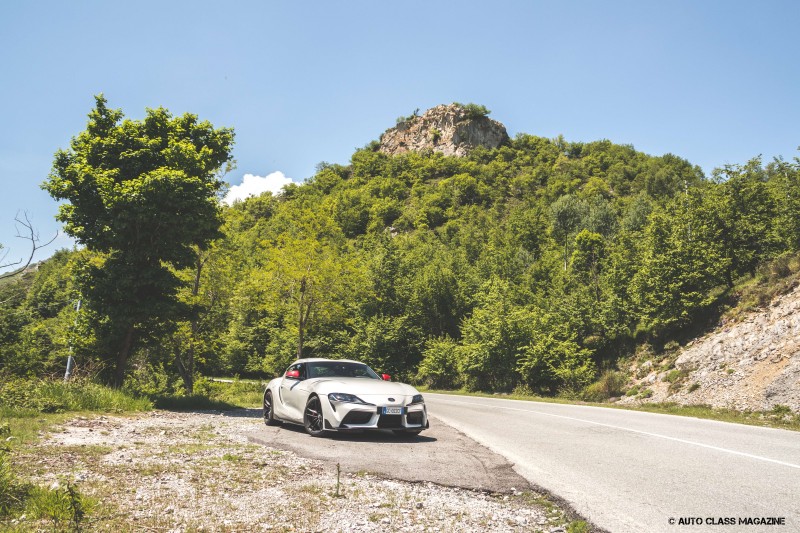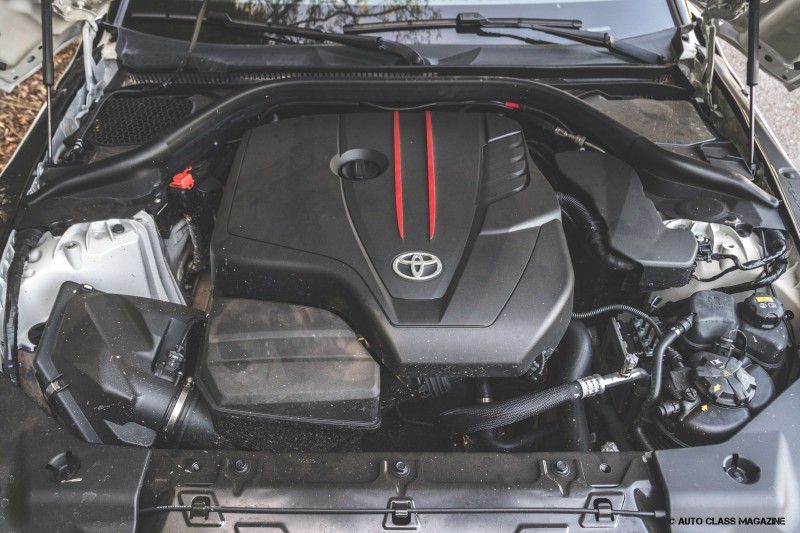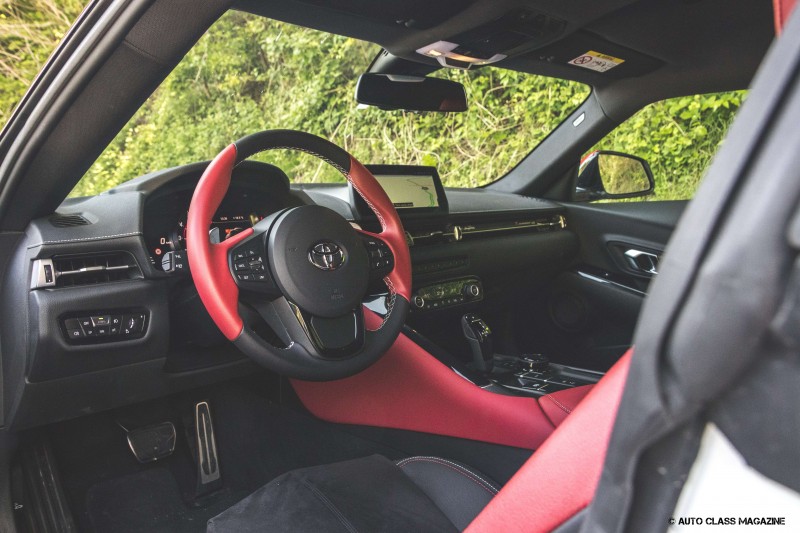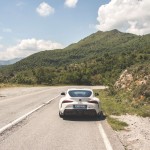With just over € 56,000 it allows us to feel like main characters in our personal episode of “The Fast & The Furious”. And then the Supra is one of those cars that go beyond those canonical brand diatribes, becoming the unsuspected alternative that might not yet been considered.
Words Andrea Balti / Photos Bruno Serra
Nowadays there are just a few things that could be taken for granted. We born, grow up, fall in love and die. Then there are taxes and if you’re lucky destiny can make a visit as well. A bit like in the case of the new Toyota Supra, which I am about to collect for our long-awaited road test. It seems it also starts appearing almost everywhere, especially in the movie that will arrive in cinemas a few weeks from now, the ninth chapter of the “Fast & Furious” saga, the same cinematic dynasty that has not only sparked interest in an often mistreated and poorly explored world of tuning, but the thing that has literally given a second chance to the second incarnation of our beloved Supra, the one produced from 1993 to 2002. The Hollywood success has had such a powerful echo that the Supra has become a symbol, even before being an excellent sports car ready to be brought to the workshop for welcoming some extra horsepower and maybe a bottle of NOS.
Fast-forward for another twenty years and “Fast9” brings a new chapter in theaters, this time with the latest generation of the Supra, the one that confirms that nothing happens by chance. Here is another certainty for you. Introduced to the global market in 2019, after a seemingly endless wait, the Supra is a project that has been perfected in detail, which is why the gestation drawing over the sinuous shapes of the FT-1 Concept was so long. By now you will know very well that this is a joint venture between Toyota and BMW, exactly as happened a few years ago for the amazing birth of the GT86, a project shared with Subaru and its BRZ. In this case, the Supra takes the structure and mechanical organs of its Z4 cousin, but offering a different product mainly due to the presence of a coupe body with a solid roof.
No hair in the wind therefore, the Gazoo Racing performance department has a very precise image of what the new generation Supra should represent and in a landscape where it is easy to get lost in futile boxes during the configuration phase, you can opt for a single set-up and two engine proposals: a 3-liter in-line 6-cylinder and a 4-cylinder 2.0-liter, both turbocharged. The sample of our test is then a limited edition built in just 200 units, named Fuji Speedway, which among other things includes 19″ matt black wheels (instead of 18″), active differential and a white bi-color paint with red details. The cockpit is basically very similar to that of the new Z4 and even in this case you certainly cannot complain about having adopted a state-of-the-art multimedia system and impeccable materials and assembly. Toyota describes it as a product ready for preparation and highlights it with the adoption of numerous fake air intakes placed all over the place, but if you are not among those willing to spend thousands of Euros browsing though some tuning catalogue, know that the Supra with the 4-cylinder is able to satisfy the appetite for curves and speed enticed by a sensational look.
After all, we are talking about an extremely low coupe, which once seated on board confirms the feeling of being at street level. The grip on the steering wheel is perfect and the visibility factor is a note that only hurts when parking, but luckily rear view cameras solve most of the problem. It is like being strapped to the seat of a fighter-bomber and if only the 2-liter had a few more decibels, you would immediately realize the kilometers per hour gained even in tight mixed conditions. In fact, if there are 82 horses of difference between the 3.0 and the 2.0, while the kilos of weight less and the agility gained with a more uniform balance of the masses allow the more modest 258-horsepower 4-cylinder to move with extreme ease between bends, instilling great confidence right from the start when it comes to keeping the gas down in the fastest bits. You can feel the turbo, but this never makes the driving experience nervous and indeed appears very linear in delivery, an even more enjoyable process thanks to the Lexus LFA-style central instrumentation. And speaking of LFA, despite the gap of hundreds of thousands of Euros between the two, the Japanese technicians are keen to point out that the GR Supra has a torsional rigidity even higher than the aforementioned exotic supercar equipped with that mighty sounding V10.
The intention to go straight to the point is also reflected in the presence of only two driving modes: Normal and Sport (in addition to Individual), which intervene on the classic parameters useful for optimizing a more civil or a more sporty use, depending how you intend to exploit the Supra for its GT or performance side. In any case, the 8-speed automatic gearbox – a torque converter – is always up to par, but the paddles on the steering wheel are essential to increase driving involvement. The GR Supra, at least in the 258 horsepower version, is not a car that has to wait for straights to allow the driver to put the throttle down, on the contrary it proves to be reactive to the point of confirming that it is not so important how many horses you have at disposal, but rather how they are exploited by those sitting in the driver’s seat.
Here’s another reason why the 5.2 seconds claimed to accelerate from 0 to 100 kph doesn’t tell the whole story. The Supra is a car capable of thrilling, regardless of the pace, but rest assured that while I am struggling with a twisted mountain road, the threshold of attention is always high, trying to straightening a tail that, with traction controls off, remember that an authentic sports car must have traction on the rear wheels only. The new Supra, thanks to the partnership with BMW and Gazoo Racing’s know-how, is the sports car that was missing, entering that market segment that does not intend to give up the practicality of a small grand tourer with a large luggage compartment and a outrageously sexy look that will never pass unnoticed.
It is one of those cars that seem to have a soul and which after a few days spent together really has a bond with you. Perhaps this is the case, because after all it is a direct descendant of a model that has imposed itself among the hearts of young enthusiasts, ousting sacred monsters like Ferrari and Lamborghini in the hunt for the best spot on the bedroom wall. Perhaps it is because with just over € 56,000 it allows us to feel like main characters in our personal episode of “The Fast & The Furious”. And then the Supra is one of those cars that go beyond those canonical brand diatribes, becoming the unsuspected alternative that might not yet been considered.
Completely immersed in its red and black leather cockpit, where every little detail has ergonomic shapes and a functional aspect, my mind bounces between the concentration towards the road in front of me and those details that make it aesthetically unique, despite not hiding the dimensions in common with the Z4. And if at the front, the long and curved bonnet may not be to everyone’s taste, the pronounced tail and the numerous ribs that characterize the sides make it an object that is also beautiful to look at. Then there is a couple of exhausts that are waiting for nothing but gain in terms of decibels and the reversing light in central position, another detail that indicates that nothing has been left to chance here. At the end of the two weeks of testing and after having really driven in any situation and condition, I can claim to have identified another certain fact of life: legends, sometimes, they come back.
TOYOTA GR SUPRA
Engine 4 cylinder Turbo, 1.998 cc Power 258 hp @ 5.000-6.500 rpm Torque 400 Nm @ 1.550-4.400 rpm
Traction Rear-Wheel-Drive Transmission 8-Speed Automatic Gearbox Weight 1.395 kg
0-100 kph 5,2 sec Top Speed 250 kph Price from €56.826 (Fuji Speedway Edition)














































